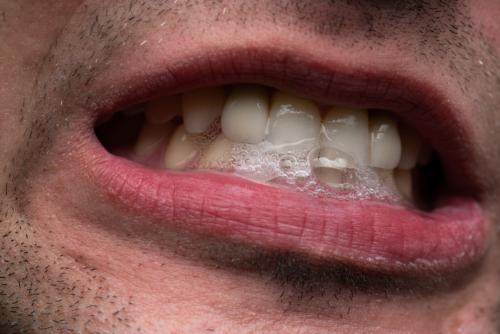Pneumococcal pneumonia - clinical manifestations, evolution, complications, treatment

The causative agent is pneumococcus. Pneumococci have a low resistance in the external environment and are susceptible to most antibiotics. Pneumococci have a wide spread, being carriers of the upper airways, where they are released into the atmosphere, especially in crowded areas. The infection is made by air (exogenous) or endogenous (pneumococcus becomes pathogenic and causes the disease). In both situations, the resistance of the body is weak and the favorable factors cause the onset of the disease. Pneumococcal transmission and increased number of healthy carriers are facilitated by respiratory, cold, agglomeration, humidity, alcohol, physical or mental health viral disorders, some chronic diseases such as heart failure, diabetes,.
The possibility of contagion exists as long as the pneumococcus persists in the respiratory secretions but stops after a few days of treatment. The incubation period lasts for 1-3 days, with no clinical symptoms. The onset of onset suddenly occurs with tachycardia, irritable cough, fever of 39-40 degrees Celsius, headache and altered general condition. There appears a submammary (on the side of the outbreak) that cuts off the patient's breath and intensifies with deep coughing or deep breathing. This period lasts 24-48 hours.
The state period is gradually being established and consists of the appearance of general signs, functional and physical pulmonary signs, laboratory and radiological signs, the general condition continuing to be altered. General signs - The temperature is maintained for 5-7-9 days, the pulse is over 100, the face is red (more on the side that corresponds to the diseased lung), headache, white tongue and burned in serious forms, dry lips, . The urine is red, red in color. Functional pulmonary signs - Patients accuse thoracic throat from the same side (rarely opposite) of the condition or abdominal (in child), lasting for 3-4 days. The patient has 30-40 breaths per minute (), the cough is initially irritable, dry, low, and after 2-3 days it becomes thick, wet, with expectoration (\.
Expectoration occurs on the 3rd day of the disease. It is rusty, viscous, aerated and very adherent. Towards the end of the disease will look mucopurulent. confirms the diagnosis, indicating an opacity with lobar or segmental, sometimes triangular location. Pneumococcal pneumonia has an evolution of 5-7-11 days.
The disease suddenly ends, through the crisis, which translates clinically by sudden drop in temperature, followed by massive, well-being. Pulmonary symptoms (coughing, and expectoration) improve. The patient removes a large amount of urine. Rarely, the disease can be prolonged, going into a chronic form with a state of poisoning of the body, followed by sequelae of pulmonary sclerosis or may develop to a pulmonary suppuration. The period of convalescence lasts for about 1-2 weeks.
Recidivism and relapses are common, as the disease does not provide immunity. The use of antibiotics shortens the course of the disease. Death can occur due to, collapse or respiratory failure. Diagnosis of pneumonia is easy to do when the patient shows the characteristic signs of the disease. In some cases, however, when some signs are missing or not too typical, the diagnosis is done with the help of radiography, to which a series of laboratory samples are associated: - The blood count will show a leukocytosis (increased number of leukocytes); .
PrognosticPrognosis is favorable, but it is also influenced by age, patient's personal terrain, associated diseases and aggression of pneumococcus. With the introduction of antibiotics, complications have been greatly reduced. Local, visceral and general complications may occur. Pleurisy may occur during or after the illness. Pulmonary abscess: Transformation of the pneumonic process into a supurative process is also possible.
Spontaneous pneumothorax or pulmonary gangrene rarely occur. Among the most common visceral and general complications are: pneumococcal meningitis, peritonitis, endocarditis. There are also toxic hepatitis, nephritis, otitis, mastoiditis. The treatment is hygienic-dietary, etiological and symptomatic. Hygiene-dietetic treatment requires bed rest as long as the fever persists and another 6-10 days after the crisis, in a bright, well-ventilated room with a mean temperature (20 degrees Celsius).
The patient must have a rich diet, eat fruit juices, tea, syrups, milk. Switching to regular food will be progressive. During the fever period, the patient needs to hydrate sufficiently. Particular attention must be paid to the removal of debris, gargarisms, the lubrication of mucous membranes with glycerol boraxate, and skin hygiene (washing with warm water and rinsing with menthol alcohol). Etiologic treatment targets pneumococcus, which is sensitive to penicillin, ampicillin, amoxicillin, amoxicillin + clavulanic acid, tetracycline, erythromycin and cotrimoxazole.
The treatment will be individualized for each patient, taking into account the clinical form and the sensitivity to antibiotics. Penicillin G is the primary antibiotic because penicillin resistant pneumococcal strains are rare. In severe cases, two antibiotics may be associated. Symptomatic treatment Alcoholized wet compresses are used to reduce fever. Thoracic fever is treated with antialgics, and agitation and delirium are counteracted by barbiturates.
Oxygen should be given in cyanosis and. To cure cough, antitussives will be recommended. .
Source : sfatulmedicului.ro
Views : 3120
Popular Article
- (photo) Nude becomes art.
Posted: 2018-03-17, 9810 views.
- The harmful effects of air conditioning on the skin
Posted: 2017-06-08, 8519 views.
- 3 causes of dyed hair discoloration
Posted: 2017-06-15, 8403 views.
- Why early puberty occurs in girls: symptoms, favors, diagnosis and treatment
Posted: 2017-10-24, 8244 views.
- Good or bad skin treatments in the hot season
Posted: 2017-06-07, 7975 views.
Recommendations
- (photo) Nude becomes art.
Posted: 2018-03-17, 9810 views.
- The harmful effects of air conditioning on the skin
Posted: 2017-06-08, 8519 views.
- 3 causes of dyed hair discoloration
Posted: 2017-06-15, 8403 views.
- Good or bad skin treatments in the hot season
Posted: 2017-06-07, 7975 views.
- Risks of practicing sports on hot days
Posted: 2017-06-12, 7549 views.
 4 effective ingredients in the fight against acne.
4 effective ingredients in the fight against acne. How to get rid of hiccups fast
How to get rid of hiccups fast The wheat bran diet: the secret of lost pounds as if by magic
The wheat bran diet: the secret of lost pounds as if by magic The recipe that will sweeten your soul this weekend!
The recipe that will sweeten your soul this weekend!  Is it dangerous or not to refreeze meat after thawing it?
Is it dangerous or not to refreeze meat after thawing it?  The unusual sign of diabetes indicated by saliva.
The unusual sign of diabetes indicated by saliva. What to drink to boost your immune system.
What to drink to boost your immune system. 10 foods that help you never age.
10 foods that help you never age. What actually happens in your body if you drink a cup of coffee for breakfast
What actually happens in your body if you drink a cup of coffee for breakfast 5 surprising benefits of chia seeds
5 surprising benefits of chia seeds